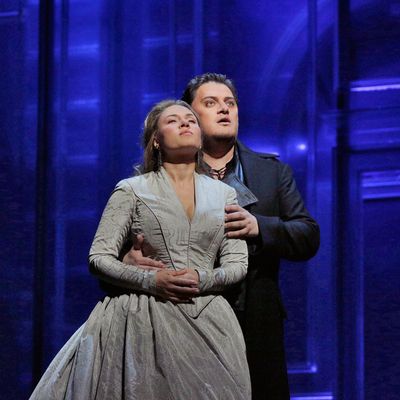
When an un-darkened Moor marched onstage during the Metropolitan Opera’s new production of Otello, he seemed confused, as if he had just crashed the wrong Act I. “Esultate,” he sang, non-exultingly. For a moment, it looked as though the Met’s season was off to a wobbly start. The chorus milled, the storm dissipated, and an all-black-clad cast seemed uncertain as to who was on whose side. Fortunately for Venice, Verdi, and the opening-night audience, Yannick Nézet-Séguin was in the pit to enforce order and wildness, violence and wit. Otello is Verdi’s opera of extremes. The weather is at its most murderous, the title character most tormented, the bad guy most depraved — and all those drastic states come geysering out of the orchestra. Woe to the singer who dithers in the face of that musical hurricane. Nézet-Séguin was not about to let that happen. The conductor kept the powerful cast locked on his signal, and the result was a performance that grew gradually more disciplined and fierce.
I have always thought of Verdi’s opera — and of Shakespeare’s play — as a piece about jealousy, competitiveness, manipulation, racism, and lethal mistrust. The Met’s new production made me see it as a more straightforward story of domestic abuse. That’s partly because Aleksandrs Antonenko, though he belongs to the tiny club of tenors who can do justice to the treacherous role, acts with the subtlety of bus stop. His Otello is a thick-skulled brute in charge of an island garrison, which helps explain why Desdemona protests her innocence, but sees no point in trying to fight back or escape. He needs no reason for his rages, which Iago could stoke without breaking a sweat.
What he lacks in dramatic presence, Antonenko compensates for in vocal intensity. His trumpetlike highs are hard, bright, and implacable, but he also commands a light half-croon full of brokenness and regret. The object of his jealousies is Sonya Yoncheva, as poised and tender a Desdemona as the Met could field just now. Her voice luminesces, her prayers flutter skywards, and the “Willow Song” is lusciously poignant. But the production’s reactor core is Željko Lučić, who generates practically enough heat to justify retitling the opera Iago. Lučić provides the full panoply of badness that a Verdi villain needs, from insinuating murmurs to threatening snarls. Listen to him delivering “Credo in un dio crudel,” and you, too, will soon believe in a cruel divinity. In the real world, not even genocidal maniacs or puppy snatchers will admit to having an evil heart; Lučić’s Iago suggests how exciting it would be if they did.
The other headliners are the dark brass chords and tectonic cellos that well up from the pit and the chorus’s trembling Cypriot crowds. Verdi projects one man’s internal tempest onto a vast scale, angering nature and upsetting the social order, and Nézet-Seguin wrangles the Met’s masses with the aplomb of a musical Eisenstein.
That’s a good thing, because the director Bartlett Sher, one of the few Broadway powerhouses who knows his way around opera, neglects to forge the link between the personal and the panoramic. Sher doesn’t ever quite control collision of grandeur and claustrophobia in Otello. The action takes place within the battlements of a Venetian outpost on Cyprus, giving the opera a hothouse colonial quality. At the Met, slow-motion surf projected on screens reminds us of the characters’ isolation. Set designer Es Devlin has rendered the city as a set of translucent acrylic boxes with neoclassical façades that trundle around as if trying to form a glass palazzo. Perhaps those see-through walls represent a civilization that consists of nothing but veneer. Or the frailty of Europe’s outpost in the middle of a hostile Mediterranean. Or the thinness of the title character’s skin. Whatever their symbolic valence, the meandering sets seemed like sketches for an unformed concept, and the singers moved cautiously around them as if to avoid a collision.
Costume designer Catherine Zuber doesn’t help matters with a repertoire of wardrobe clichés. She didn’t really need to bother providing Iago with his evildoer’s outfit, a long black leather coat — she could just have recycled the battered jacket Lučić wore as Macbeth, or the alligator-skin number that makes Scarpia look so ruthless in the Met’s current Tosca. I suppose black leather is the new black hat.
Or maybe that murky garment is meant to compensate for Antonenko’s pale Latvian face. For the first time in its history, the Met has proudly renounced its tradition of blacking up Otello. (It has also — not for the first time — declined to commit some of the more overtly racist lines to the translated titles.) The move is long overdue, because the history of blackface is one of mockery, not verisimilitude. It won’t be missed. If the dramatic impact of an operatic performance depends on the right shade of greasepaint, then the production’s got deeper problems. Nor is it necessary to keep the role on ice until the advent of the right black tenor. One pairing I would have killed to experience live is Plácido Domingo opposite the African-American soprano Leontyne Price, who sang Desdemona’s arias but never the entire role. Racial hatred often doesn’t depend on actual skin color; opera never does.





